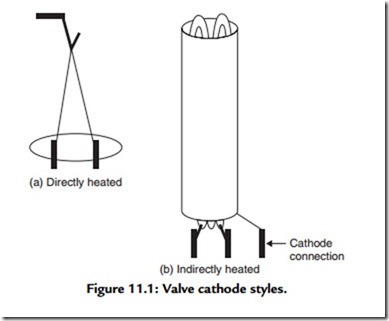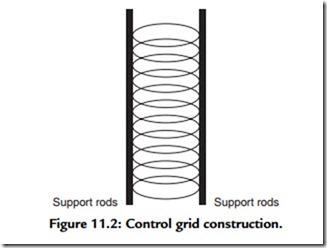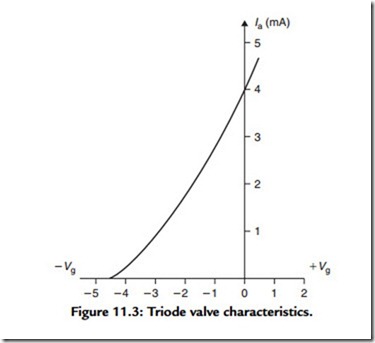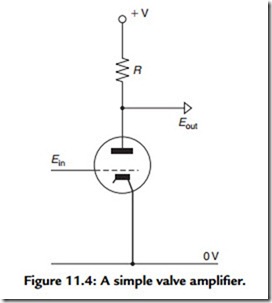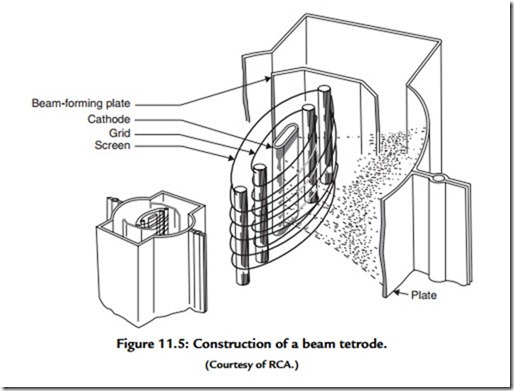Although the bulk of modern electronic circuitry is based on “solid-state” components, for very good engineering reasons—one could not, for example, build a compact disc player using valves and still have room in one’s house to sit down and listen to it—all the early audio amplifiers were based on valves, and it is useful to know how these worked and what the design problems and circuit options were in order to get a better understanding of the technology. Also, there is still interest on the part of some “hi-fi” enthusiasts in the construction and use of valve-operated audio amplifiers, and additional information on valve based circuitry may be welcomed by them.
Valves or Vacuum Tubes
The term thermionic valve (or valve for short) was given, by its inventor, Sir Ambrose Fleming, to the earliest of these devices, a rectifying diode. Fleming chose the name because of the similarity of its action in allowing only a one-way flow of current to that of a one-way air valve on an inflatable tire, and the way it operated was by controlling the internal flow of thermally generated electrons, which he called “thermions,” hence the term thermionic valve. In the United States they are called “vacuum tubes.” These devices consist of a heated cathode, mounted, in vacuum, inside a sealed glass or metal tube. Other electrodes, such as anodes or grids, are then arranged around the cathode so that various different functions can be performed.
The descriptive names given to the various types of valve are based on the number of its internal electrodes so that a valve with two electrodes (a cathode and an anode) is called a “diode,” one with three electrodes (a cathode, a grid, and an anode) is called a “triode,” one with four (a cathode, two grids, and an anode) is called a “tetrode,” and so on.
Cathode connection
It helps to understand the way in which valves work, and how to get the best performance from them, if one understands the functions of these internal electrodes and the way in which different groupings of them affect the characteristics of the valve, so, to this end, I have listed them and examined their functions separately.
The Cathode
This component is at the heart of any valve and is the source of the electrons with which it operates. It is made in one of two forms: either a short length of resistor wire, made of nickel, folded into a ‘V’ shape and supported between a pair of stiff wires at its base and a light tension spring at its top, as shown in Figure 11.1(a), or a metallic tube, usually made of nickel, with a bundle of nickel or tungsten heater wires gathered inside it, as shown in Figure 11.1(b). Whether the cathode is a directly heated “filament” or an indirectly heated metal cylinder, its function and method of operation are the same, although, other things being equal, the directly heated filament is much more efficient in terms of the available electron emission from the cathode in relation to the amount of power required to heat it to its required operating temperature (about 775°C for one having an oxide-coated construction).
It is possible to use a plain tungsten filament as a cathode, but it needs to be heated to some 2500°C to be usable, which requires quite a substantial amount of power and leads to other problems, such as fragility. Virtually all contemporary low to medium power valves use oxide-coated cathodes, which are made from a mixture of the oxides of calcium, barium, and strontium deposited on a nickel substrate.
In the manufacture of the valve, these chemicals are applied to the cathode as a paste composed of a binding agent, the metals in the form of their carbonates, and some small quantities of doping agents, typically of rare-earth origin. The metal carbonates are then reduced to their oxides by subsequent heating during the last stage in the process of evacuating the air from the valve envelope.
In use, a chemical reaction occurs between the oxide coating and the heated nickel cathode tube (or the directly heated filament), which causes the alkali metal oxides to be locally reduced to the free metal, which then slowly diffuses out to the cathode surface to form the electron-emitting layer. The extent of electronic emission from the cathode depends critically upon its temperature, and the value chosen for this in practice is a compromise between performance and life expectancy, as higher cathode temperatures lead to shorter cathode life due to the loss through evaporation of the active cathode metals, whereas a lower limit to the working temperature is set by the need to have an adequate level of electron emission.
When hot, the cathode will emit electrons, which form a cloud around it, a situation in which the thermal agitation of the electrons in the cathode body, which causes electrons to escape from its surface, is balanced by the growing positive charge that the cathode has acquired as the result of the loss of these electrons. This electron cloud is called the “space charge” and plays an important part in the operation of the valve; a matter that is discussed later.
The Anode
In the simplest form of valve, the diode, the cathode is surrounded by a metal tube or box, called the anode or plate. This is usually made of nickel and will attract electrons from the space charge if it is made positive with regard to the cathode. The amount of current that will flow depends on the closeness of the anode box to the cathode, the effective area of the cathode, the voltage on the anode, and the cathode temperature. For a fixed cathode temperature and anode voltage, the ratio of anode voltage to current flow determines the anode current resistance, Ra, which is measured by the current flow for a given applied voltage— as shown in the equation
Because the anode is bombarded by electrons accelerated toward it by the applied anode voltage, when they collide with the anode their kinetic energy is converted into heat, which raises the anode temperature. This heat evolution is normally unimportant, except in the case of power rectifiers or power output valves, when care should be taken to ensure that the makers’ current and voltage ratings are not exceeded. In particular, there is an inherent problem that if the anode becomes too hot, any gases that have been trapped in pores within its structure will be released, and this will impair the vacuum within the valve, which can lead to other problems.
The Control Grid
If the cathode is surrounded by a wire grid or mesh—in practice, this will usually take the form of a spiral coil, spot welded between two stiff supporting wires, of the form shown in Figure 11.2—the current flow from the cathode to the anode can be controlled by the voltage applied to the grid, such that if the grid is made positive, more negatively charged electrons will be attracted away from the cathode and encouraged to continue on their way to the anode. However, if the grid is made negative, it will repel the electrons emitted by the cathode and reduce the current flow to the anode.
It is this quality that is the most useful aspect of a valve in that a quite large anode current flow can be controlled by a relatively small voltage applied to the grid, and so long as the grid is not allowed to swing positive with respect to the cathode, no current will flow in the grid circuit, and its effective input impedance at low frequencies will be almost infinite. This ability to regulate a large current at a high voltage by a much smaller control voltage allows the valve to amplify small electrical signals, and since the relationship between grid voltage and anode current is relatively linear, as shown in Figure 11.3, this amplification will cause relatively little distortion in the amplified signal. The theoretical amplification factor of a valve, operating into an infinitely high impedance anode load, is denoted by the Greek symbol μ.
Although there may be several grids between the cathode and the anode in more complex valves, the grid closest to the cathode will have the greatest influence on the anode current flow, which is therefore usually called the control grid.
The effectiveness of the grid in regulating the anode current depends on the relative proximity of the grid and the anode to the cathode, in that, if the grid is close to the cathode, but the anode is relatively remote, the effectiveness of the grid in determining the anode current will be much greater and will therefore give a higher value of μ than if the anode is closer to the grid and cathode. Unfortunately, there is a snag in that the
anode current resistance of the valve, Ra, is also related to the anode/cathode spacing and becomes higher as the anode/cathode spacing is increased. The closeness of the pitch of the wire spiral that forms the grid also affects the anode current resistance in that a close spacing will lead to a high Ra, and vice versa.
The stage gain (M) of a simple valve amplifier, of the kind shown in Figure 11.4, is given by the equation
so that a low impedance valve, such as a 6SN7 (typical Ia = 9 mA, Ra = 7.7 K, μ = 20), which has close anode–grid and grid–cathode spacings, and a relatively open pitch in the grid wire spiral, will have a high possible anode current but a low amplification factor, while a high impedance valve such as a 6SL7 (typical Ia = 2.3 mA, Ra = 44 K, μ = 70) will have a low stage gain unless the circuit used has a high value of anode load resistance (R), which, in turn, will demand a high value of HT voltage.
The Space Charge
Although a cloud of electrons will surround any heated cathode mounted in a vacuum and will act as a reservoir of electrons when these are drawn off as anode current, their
presence becomes of particular importance when a negatively charged control grid is introduced into the system, in that the electron cloud will effectively fill the space between the cathode and the grid and will act as the principal source of electrons.
The presence of this electron cloud—known as the space charge—has several important operational advantages. Of these the first is that, by acting as an electron reservoir, it allows larger, brief-duration, current flows than would be available from the cathode on its own and that it acts as a measure of protection to the cathode against the impacts of positive ions created by electronic collisions with the residual gases in the envelope, as these ions will be attracted toward the more negatively charged cathode. Finally, left to itself, the electronic emission from the cathode suffers from both “shot” and “flicker” noise, a current fluctuation that is averaged out if the anode current is drawn from the space charge.
This random emission of electrons from a space charge-depleted cathode is used to advantage in a “noise diode,” a wide-band noise source that consists of a valve in which the cathode is deliberately operated at a low temperature to prevent a space charge from forming so that a resultant noisy current can be drawn off by the anode.
In the case of a triode used as an output power valve, where large anode currents are needed, the grid mesh must be coarse and the grid–cathode spacing must be close. This limits the formation of an adequate space charge in the grid–cathode gap, and, in its absence, the cathode must have higher emission efficiency than would be practicable with an indirectly heated system, which means that a directly heated filament must be used instead. Usually, the filament voltage will be low to minimize cathode-induced “hum” and the filament current will be high because of the size of the filament (2.5 A at 2.5 V in the case of the 2A3 valve).
Directly heated cathodes are also commonly used in valve HT rectifiers, such as the 5U4 or the 5Y3, because the higher cathode emission reduces the voltage drop across the valve and increases the available HT output voltage by comparison with a similar power supply using an indirectly heated cathode type.
Tetrodes and Pentodes
Although the triode valve has a number of advantages as an amplifier, such as a low noise and low distortion factor, it suffers from the snag that there will be a significant capacitance, typically of the order of 2.5 pF, between the grid and the anode. In itself, this latter capacitance would seem to be too small to be troublesome, but, in an amplifying stage with a gain of, say, 100, the Miller effect will increase the capacitance by a factor of 101, increasing the effective input capacitance to 252.5 pF, which could influence the performance of the stage.
When triode valves were used as RF amplifiers, in the early years of radio, this anode– grid capacitance caused unwanted RF instability, and the solution adopted was the introduction of a “screening” grid between the triode control grid and its anode, which reduced this anode–grid capacitance, in the case of a screened grid or tetrode valve, to some 0.025 pF.
A further effect that the inclusion of a screening grid had upon the valve characteristics was to make the anode current, in its linear region, almost independent of the anode voltage, which led to very high values for Ra and μ. Unfortunately, the presence of this grid caused a problem that when the anode voltage fell, during dynamic conditions, to less than that of the screening grid, electrons hitting the anode could cause secondary electrons to be ejected from its surface, especially if the anode was hot or its surface had been contaminated by cathode material, and these would be collected by the screening grid, which would cause a kink in the anode current/voltage characteristics. While this might not matter much in an RF amplifier, it would cause an unacceptable level of distortion if used in an audio amplifier stage.
Two solutions were found for this problem, of which the simplest was to interpose an additional, open mesh grid between the anode and the screening grid. This grid will normally be connected to the cathode, either externally or within the valve envelope, and is called the suppressor grid because it acts to suppress the emission of secondary electrons from the anode.
Since this type of valve had five electrodes it was called a “pentode.” A typical small- signal pentode designed specifically for use in audio systems is the EF86, in which steps have also been taken to reduce the problem of microphony when the valve is used in the early stages of an amplifying system. The EF86 also has a wire mesh screen inside the glass envelope and surrounding the whole of the electrode structure. This is connected to pins 2 and 7 and is intended to lessen the influence of external voltage fields on the electron flow between the valve electrodes.
In use, a small-signal pentode amplifying stage will give a much higher stage gain than a medium impedance triode valve (250˘ in comparison with, say, 30˘). It will also have a better HF gain due to its lower effective anode–grid capacitance. However, a triode gain stage will probably have a distortion figure, other things being equal, which is about half that of a pentode.
The second solution to the problem of anode current nonlinearity in tetrodes, particularly suited to the output stages of audio amplifiers, was alignment of the wires of the control grid and screening grid so that they constrained the electron flow into a series of beams, which served to sweep any secondary electrons back toward the anode—a process that was helped by the inclusion within the anode box of a pair of “beam-confining electrodes,” which modified the internal electrostatic field pattern. These are connected to the cathode internally and take the form shown in Figure 11.5. These valves were called beam tetrodes or kinkless tetrodes and had a lower distortion than output pentodes. Valves of this type, such as the 6L6, the 807, and the KT66 and KT88, were widely employed in the output stages of the high-quality audio amplifiers of the 1950s and early 1960s.
Both pentodes and beam tetrodes can be used with their screen grids connected to their anodes. In this mode their characteristics will resemble a triode having similar grid– cathode and grid–anode spacings to the grid–cathode and grid–screen grid spacings of the pentode. The most common use of this form of connection is in power output stages, where a triode connected beam tetrode will behave much like a power triode, without the need for a directly heated (and hum-inducing) cathode.
Valve Parameters
In addition to the anode current resistance, Ra, and the amplification factor, μ, mentioned earlier, there is also the valve slope or mutual conductance (gm), which is a measure of the extent to which the anode current will be changed by a change in grid voltage. Traditionally, this would be quoted in milliamperes per volt (mA/V or milli-Siemens, written as mS) and would be a useful indication of the likely stage gain given by the valve in an amplifying circuit.
This would be particularly helpful in the case of a pentode amplifying stage, where the value of Ra would probably be very high in comparison with the likely value of load resistance. (For example, in the case of the EF86, Ra is quoted as 2.5 MΩ and the gm
is 2 mA/V.) In this case, the stage gain (M) can be determined, approximately, by the relationship M = –gm · RL, which, for a 100 k anode load would be = -200˘.
The various valve characteristics are defined mathematically as
Preservation of a high vacuum within its envelope is essential to the life expectancy and proper operation of the valve. However, it is difficult to remove all traces of residual gas on the initial pumping out of the envelope, quite apart from the small but continuing gas
evolution from the cathode, or any other electrodes that may become hot in use. The solution to this problem is the inclusion of a small container, known as a boat, mounted somewhere within the envelope, but facing away from the valve electrodes, which contains a small quantity of reactive material, such as metallic calcium and magnesium.
The boat is positioned so that after the pumping out of the envelope has been completed, and the valve had been sealed off, the getter could be caused to evaporate on to the inner face of the envelope by heating the boat with an induction heating coil. Care is taken to ensure that as little as possible of the getter material finds its way on to the inner faces of the valve electrodes, where it may cause secondary emission, or on to the mica spacers, where it may cause leakage currents between the electrodes.
While this technique is reasonably effective in cleaning up the gas traces that arise during use of the valve, the vacuum is never absolute, and evidence of the residual gas can sometimes be seen as a faint, deep blue glow in the space within the anode envelope of a power output valve. If, however, there is a crack in the glass envelope, or some other cause of significant air leakage into the valve interior, this will become apparent because of a whitening of the edges of the normally dark, mirror-like surface of the getter deposit on the inside of the valve envelope. A further sign of the ingress of air into the valve envelope is the presence of a pinkish-violet glow that extends beyond the confines of the anode box. By this time the valve must be removed and discarded to prevent damage to other circuit components through an increasing and uncontrolled current flow.
Cathode and Heater Ratings
For optimum performance, the cathode temperature should be maintained, when in use, at its optimum value, which requires that the heater or filament voltages should be set at the correct levels. Since the voltage of the domestic AC power supply is not constant, the design ratings for the heater or filament supply must take account of this. However, this is not as difficult to do as it might appear. For example, Brimar, a well-known valve manufacturer, makes the following recommendations in their Valve and Teletube Manual: “the heater supply voltages should be within ±5% of the rated value when the heater transformer is fed with its nominal input voltage, provided that the mains power supply is within ±10% of its declared value.”
An additional requirement is that, because of inevitable cathode-heater leakage currents, the voltages between these electrodes should be kept as low as possible and should not exceed 200 V. Moreover, there must always be a resistive path, not exceeding 250 kΩ, between the cathode and heater circuits.
As a practical point, the wiring of the heater circuit, which is usually operated at 6.3 V AC, will normally be installed as a twisted pair to minimize the induction of mains hum into sensitive parts of the system, as will the heater wiring inside the cathode tube of low noise valves, such as the EF86. With modern components, such as silicon diodes and low- cost regulator ICs, there is no good reason why the heater supplies to high-quality valve amplifiers should not be derived from smoothed and stabilized DC sources.
It has been suggested that the cathodes of valves can be damaged by reverse direction ionic bombardment if the HT voltage is applied before the cathode has had a chance to warm up and form a space charge, and that the valve heaters should be left on to avoid this problem. In practice, this problem does not arise because gaseous ions are only formed by collisions between residual gas molecules and the electrons in the anode current stream. If the cathode has not reached operating temperature there will be little or no anode current and, consequently, no gaseous ions produced as a result of it. Brimar specifically warns against leaving the cathode heated, in the absence of anode current, in that this may lead to cathode poisoning because of chemical reactions occurring between the exposed reactive metal of the cathode surface and any gaseous contaminants present within the envelope. Unfortunately, the loss of electron emissivity as the cathode temperature is reduced occurs more rapidly than the reduction in the chemical reactivity of the cathode metals.
Indirectly heated HT rectifier valves have been used, despite their lower operating efficiency, to ensure that the full HT voltage was not applied to the equipment before the other valves had warmed up. This was done to avoid the HT rail overvoltage surge that would otherwise occur and allow the safe use of lower working voltage and less expensive components, such as HT reservoir, smoothing, or intervalve coupling capacitors.
Microphony
Any physical vibration of the grid (or filament, in the case of a directly heated cathode) will, by altering the grid–cathode spacing, cause a fluctuation of the anode current, which will cause an audible ringing sound when the envelope is tapped—an effect known as microphony in the case of a valve used in audio circuitry. Great care must therefore be taken in the manufacture of valves to maintain the firmness of the mounting of the grids and other electrodes. This is done by the use of rigid supporting struts whose ends are located in holes punched in stiff mica disc-shaped spacers, which, in turn, are a tight fit within the valve envelope.
Since a microphonic valve will pick up vibration from any sound source, such as a loudspeaker system in proximity to it, and convert these sounds into (inevitably distorted) electrical signals, which will be added to the amplifier output, this can be a significant, but unsuspected, source of signal distortion, which will not be revealed during laboratory testing on a resistive dummy load. Because it is difficult to avoid valve microphony completely, and it is equally difficult to sound proof amplifiers, this type of distortion will always occur unless such valve amplifier systems are operated at a low volume level or the amplifier is located in a room remote from the loudspeakers.
